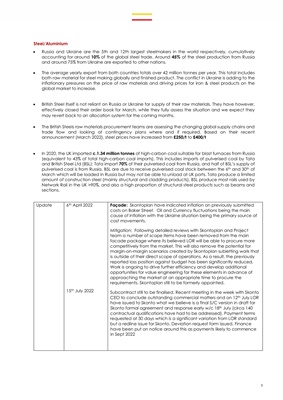
5
Steel/Aluminium
• Russia and Ukraine are the 5th and 12th largest steelmakers in the world respectively, cumulatively
accounting for around 10% of the global steel trade. Around 45% of the steel production from Russia
and around 75% from Ukraine are exported to other nations.
• The average yearly export from both countries totals over 42 million tonnes per year. This total includes
both raw material for steel making globally and finished product. The conflict in Ukraine is adding to the
inflationary pressures on the price of raw materials and driving prices for iron & steel products on the
global market to increase.
• British Steel itself is not reliant on Russia or Ukraine for supply of their raw materials. They have however,
effectively closed their order book for March, while they fully assess the situation and we expect they
may revert back to an allocation system for the coming months.
• The British Steels raw materials procurement teams are assessing the changing global supply chains and
trade flow and looking at contingency plans where and if required. Based on their recent
announcement (March 2022), steel prices have increased from £250/t to £400/t
• In 2020, the UK imported c.1.34 million tonnes of high-carbon coal suitable for blast furnaces from Russia
(equivalent to 43% of total high-carbon coal imports). This includes imports of pulverised coal by Tata
and British Steel Ltd (BSL): Tata import 70% of their pulverised coal from Russia, and half of BSL's supply of
pulverised coal is from Russia. BSL are due to receive pulverised coal stock between the 6th and 30th of
March which will be loaded in Russia but may not be able to unload at UK ports. Tata produce a limited
amount of construction steel (mainly structural and cladding products), BSL produce most rails used by
Network Rail in the UK >90%, and also a high proportion of structural steel products such as beams and
sections.
Update 6th April 2022
15th July 2022
Façade: Skontoplan have indicated inflation on previously submitted
costs on Baker Street. Oil and Currency fluctuations being the main
cause of inflation with the Ukraine situation being the primary source of
cost movements.
Mitigation: Following detailed reviews with Skontoplan and Project
team a number of scope items have been removed from the main
facade package where its believed LOR will be able to procure more
competitively from the market. This will also remove the potential for
margin-on-margin scenarios created by Skontoplan subletting work that
is outside of their direct scope of operations. As a result, the previously
reported loss position against budget has been significantly reduced.
Work is ongoing to drive further efficiency and develop additional
opportunities for value engineering for these elements in advance of
approaching the market at an appropriate time to procure the
requirements. Skontoplan still to be formerly appointed.
Subcontract still to be finalised. Recent meeting in the week with Skonto
CEO to conclude outstanding commercial matters and on 12th July LOR
have issued to Skonto what we believe is a final S/C version in draft for
Skonto formal agreement and response early w/c 18th July (circa 140
contractual qualifications have had to be addressed). Payment terms
requested at 30 days which is a significant variation from LOR standard
but a redline issue for Skonto. Deviation request form issued. Finance
have been put on notice around this as payments likely to commence
in Sept 2022